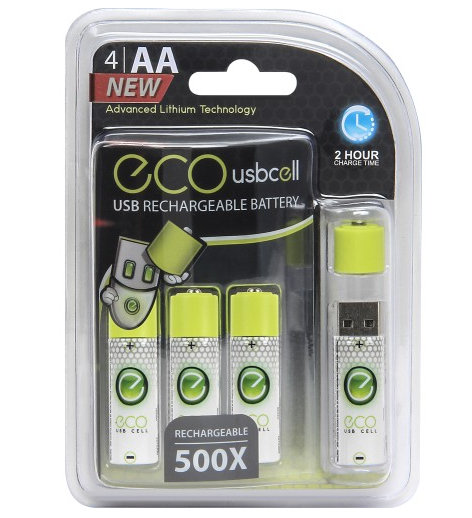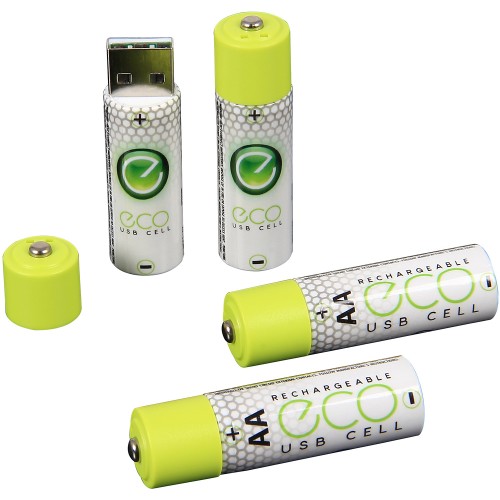
Many thanks to SWLing Post reader, Steven Crawford, who writes:
Avid follower of your SWL Blog and site. I saw these and thought your followers may find these AA and AAA lithium ion USB rechargeable cells may be of interest as they are limited to 1.5 volts. I’m interested for my C. Crane Pocket SW and Sony ICF-SW7600GR as well as for various Mag Instrument flashlights.
An excerpt from PCWorld:
Card-carrying members of the Radio Shack Battery of the Month Club, get ready to salivate: The Eco USBcell is the most exciting development we’ve seen in rechargeable batteries in a long time.
Unlike most rechargeable AA and AAA cells that use nickel metal hydride chemistry, the USBcell’s are based on the same advanced lithium polymer technology that’s used in many smartphones.
That may not sound like a big deal, but one limiting factor in using LiPo in a AA or AAA battery is voltage. LiPo and Lithium Ion’s typical minimum voltage is 3.7 volts and would fry a standard device looking for 1.5 volts.
The Eco USBcell features a power control chip to match the voltage to the standard disposable alkalines we’re used to.
[…]And that’s not even the slick part of the USBcell. Once the battery is dead, you simply pull the top off to reveal a standard USB Type A port. That means there’s no need to carry a charger anymore. Plug it into a 1 amp wall-wart charger and it’ll be topped off in about two hours, even flashing an embedded green LED to let you know. The company says it can technically be charged on a computer’s USB port, but it’ll be a lot slower.
Click here to read the article in PCWorld.
 Thanks, Steven! This is a very cool product, indeed! I noticed that, on BestBuy, there are currently six reviews–dating back to October ’15–with a full 5 star rating. Not bad.
Thanks, Steven! This is a very cool product, indeed! I noticed that, on BestBuy, there are currently six reviews–dating back to October ’15–with a full 5 star rating. Not bad.
With USB ports and chargers being ubiquitous in our world, I can see where charging these would be very convenient.
My only hesitation is that I have a healthy fear of LiPo batteries after having a GoalZero LiPo pack melt down and burn on my bed while charging once. That was three years ago, however, and charging circuits have become much more reliable since then.
I’ll put these on my wish list and purchase them later in the year if the reviews remain positive. I just purchased a 12 pack of Panasonic Enloop cells, so I’m in no hurry.
Thanks again for the tip, Steven!
By the way, if you’re confused by various battery chemistries, check out our recent rechargeable battery primer by clicking here.

Does anyone have experience using these batteries in cold weather (-20°C/0°F)?
Common wisdom is that Li batteries operate well in cold temperatures, but the minimum operating temperature listed on Best Buy is 32° F. Not very cold.
I’m not sure I’m getting the point of these batteries, apart from the “2 hours to top them off” – obviously they have a capacity of 1040mAh – I have 2500mAh Ni-MHs in my PL-660 and they keep the radio playing for like 30 hours. I have to charge them once a month or two, which takes 7-8 hours over night, not an issue for me. The Li-Po batteries might give me less than half of the mileage. On the bright side, they are self-draining much less and apparently they roughly cost the same as some proper Ni-MH cells, which is less than I expected.
If you have one available USB port, for a device that uses 4 batteries it would take 8 hours to recharge all 4. Multiple USB ports on a desktop might be too close together to accommodate plugging in more than one battery at a time.
Can anyone recommend a stand-alone AC (mains) to USB wall wart converter / adapter?
The tecsun pl880 also suffers from RF noise when plugged inn. I have tried several different chargers and to my conclusion, the tecsun charger produced the least noise (was sent with the radio direct from aon).
This seems to be an issue with all portable SW radios that may be operated with wall wart power supplies. Whether AC/DC (typical) or AC/AC (Sangean 909X) wall warts cause noise and other issues when using the radios for SW reception. Virtually everyone who listens to SW long enough on these AC powered portables will discover this highly irritating issue if they get curious enough to compare wall wart powered reception to battery powered reception over a wide range of SW frequencies.
The noise and station ghosting can be caused by the wall wart itself and by devices running on your home wiring circuits. RFI from light dimmers, fluorescent lights (including CFLs), TVs and monitors both CRT and flat screen, battery chargers, led lights, computers, electronic gas igniters, other wall warts, etc. travels along home wiring to the front end of your radio. The list of devices that generate RFI on SW is almost endless. The RFI may also reach your radio over the air.
The easiest solution is to use battery power for listening to SW. Purchasing of a better power supply may be an option. Even if operating from battery power inside a house it’s a good idea to locate and deal with household devices that cause RFI.
An eBay search for 1.5 V lithium batteries yields a good number of relevant results:
http://www.ebay.com/sch/i.html?_trksid=p2050601.m570.l1313&_nkw=1.5V+lithium+battery&_sacat=0&_from=R40
Just noticed these on Groupon for $16.99 for four AA and $18.99 for four AAA batteries. They also have a 4-cell charger for around $8. Not sure how long they’ll be available there.
Most gear I have has built in charging capability which I like very much as I don’t have to keep opening flimsy or finicky battery covers and yanking cells in and out which you would need to do more often with these. Still, 2 hours instead of 14 or so does sound very nice. Besides, 1.5 V means it will work brilliantly in voltage critical receivers such as the 909x for proper SW RF performance….
I agree that SW sensitivity on the 909X is affected by battery voltage. The 909X will receive a stable signal with equal strength using either the AC/AC wall wart for power, four new alkalines or four freshly charged NiMH batteries which charge to about 1.5V per cell in the 909X built-in charger. I assume the same would hold true for the Eco USBcells that also charge to 1.5V. I’m guessing that LiPo Eco UBBcells could be charged safely in the 909X battery bay but I don’t know this for sure.
I use only battery power when listening to SW on the 909X. When I run Eneloop white NiMH cells in the 909X I will see SW sensitivity begin to drop slightly after 2-3 hours of operation at medium speaker volume. After another 5-7 hours of operation I’ll see the first battery meter bar go out.
If I’m doing casual SW listening this winter like ABC, RNZ, RHC, CRI or BBC then I don’t sweat the minor sensitivity loss and recharge the Eneloops after the first battery meter goes out. If I’m getting picky about weak signals then I generally recharge the Eneloops after 2-3 hours of operation. Recharging Eneloops inside the 909X at this point requires only 20 minutes or so. No problem with frequent topping off. The Eneloops whites are good for up to 2100 charge cycles.
Now, a good Duracell alkaline AA is going to start off at 1.6V+. It will operate the 909X longer than the Eneloops or the Eco USBcells before showing enough voltage drop to affect SW sensitivity. But, the Coppertops aren’t rechargeable.
Other than plugging the AC/AC wall wart into the 909X batteries for charging the only special attention I give to the Eneloops is to rotate the battery bay position of the four cells once a month or so. It’s coming up on 0900 UTC ten minutes from now. I’ll check out RNZ and ABC for a few minutes before hitting the rack.
Four Eco USBcell AAs could be used to power the 909X but on second thought I doubt they could be charged with the 909X built-in battery charger. The reason? Eco USBcells have their own charging circuity built into the green plastic battery cap and are designed to be plugged into the 5V from a USB line to charge. The 909X has a built-in battery charger that is designed to charge batteries that do not have their own built-in charging circuitry.
Correction: the built-in charging circuits for the Eco USBcells must be in the battery body, not the green cap.
Interesting product, but beware! The built-in voltage changer chip may produce RF noise! Not only while charging but also when the cells are used in a radio.
Thanks for passing along info on the new Eco USBCELL AA batteries. It’s a nice design. These cells pop their tops and plug into a USB socket.
I have a little experience running LiPo batteries in RC cars and miniquads (love those things). Although LiPo batteries been around for a long time this battery chemistry is still hard to beat for high drain applications. RC’ers also know that the lightweight and soft-bodied LiPo pouch batteries will vent violently if damaged but I’m sure the Eco USBCELL cylindrical batteries have been well-armored.
I looked at the specs for the Eco USBCELL AA battery at the manufacturer’s website:
Specification: AA
Input: 5V/0.45A
Output: 1.5V, 1A
Capacity: 1040 mAh
Charge Time: 2 Hours
Recharge Cycle: 500x
For use in radios the 1A output for 1.5V is very good. Battery capacity is half of that from Eneloop NiMn AA and about 40% better than than from a similarly sized Li-ion 14500 battery (3.7V AW brand LiMn). On the plus side the Eco USBcell has a fast charge time. Lifespan: the Eco USBcell is a better than the 300 charge cycles quoted for most Li-ion batteries and a quarter of the 2100 charge cycles listed for Eneloop white AAs.
I’ll assume the voltage regulating chip on these batteries is RFI-free.